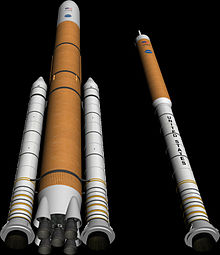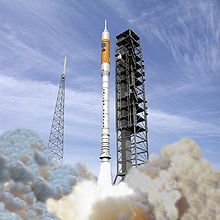Ares I
[5] However, the Constellation program, including Ares I, was cancelled by U.S. president Barack Obama in October 2010 with the passage of his 2010 NASA authorization bill.
In September 2011, NASA detailed the Space Launch System as its new vehicle for human exploration beyond Earth's orbit.
[6] In 1995 Lockheed Martin produced an Advanced Transportation System Studies (ATSS) report for the Marshall Space Flight Center.
[9] Shortly after the initial design was approved, additional tests revealed that the Orion spacecraft would be too heavy for the four-segment booster to lift,[10] and in January 2006 NASA announced they would slightly reduce the size of the Orion spacecraft, add a fifth segment to the solid-rocket first stage, and replace the single SSME with the Apollo-derived J-2X motor.
[12] The Exploration Systems Architecture Study concluded that the cost and safety of the Ares was superior to that of either of the Evolved Expendable Launch Vehicle (EELVs).
[8] The facilities for the current EELVs (LC-37 for Delta IV, LC-41 for Atlas V) are in place and could be modified, but this may not have been the most cost effective solution as LC-37 is a contractor owned and operated (COGO) facility and modifications for the Delta IV H were determined to be similar to those required for Ares I.
Ares I might have also delivered some (limited) resources to orbit, including supplies for the International Space Station or subsequent delivery to the planned lunar base.
[5] NASA selected Alliant Techsystems, the builder of the Space Shuttle Solid Rocket Boosters, as the prime contractor for the Ares I first stage.
This air-start capability was critical, especially in the original J-2 engine used on the Saturn V's S-IVB stage, to propel the Apollo spacecraft to the Moon.
The Space Shuttle Main Engine, on the other hand, would have required extensive modifications to add an air-start capability[23][12] On January 4, 2007, NASA announced that the Ares I had completed its system requirements review, the first such review completed for any crewed spacecraft design since the Space Shuttle.
[24] This review was the first major milestone in the design process, and was intended to ensure that the Ares I launch system met all the requirements necessary for the Constellation Program.
This would have provided a significant mass saving and eliminated the need to design a second stage interstage unit that would have had to carry the weight of the Orion spacecraft with it.
[17] In January 2008, NASA Watch revealed that the first stage solid rocket of the Ares I could have created high vibrations during the first few minutes of ascent.
[25] NASA officials had identified the potential problem at the Ares I system design review in late October 2007, stating in a press release that it wanted to solve it by March 2008.
[29] A study released in July 2009 by the 45th Space Wing of the US Air Force concluded that an abort 30–60 seconds after launch would have a ≈100% chance of killing all crew, due to the capsule being engulfed until ground impact by a cloud of 4,000 °F (2,200 °C) solid propellant fragments, which would melt the capsule's nylon parachute material.
[34][35] NASA conducted a successful 500-second test firing of the J-2X rocket engine at John C. Stennis Space Center in November 2011.
If the Ares I system were flown multiple times a year the marginal costs could have fallen to as low as $138 million per launch.
[51] Representative Robert Aderholt stated in March 2010 that he had received a letter from NASA which claimed that it would have cost $1.1 billion to fly the Ares I rocket three times a year.
By the Ares I first stage ground test, the case, grain design, number of segments, insulation, liner, throat diameter, thermal protection systems and nozzle had all changed.
Using a concept going back to the Apollo program, the "intertank" structure was dropped to decrease mass, and in its place, a common bulkhead, similar to that used on both the S-II and S-IVB stages of the Saturn V, would have been used between the tanks.






